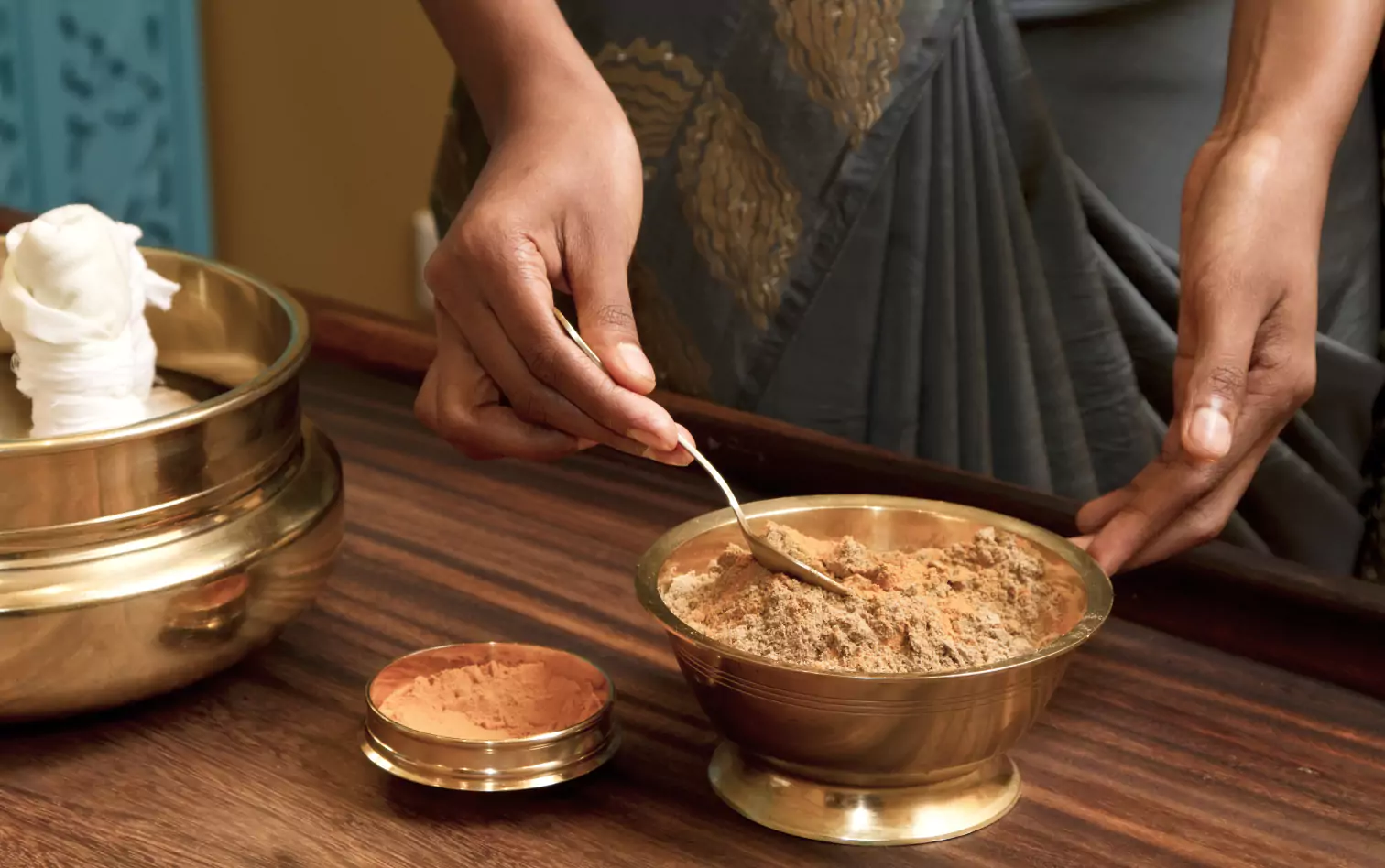A Guide to Ayurveda

Key Takeways
From acupuncture to chiropractic treatments and homeopathy to holistic healing, complementary and alternative medicine is increasing in popularity. These alternative therapies often draw from ancient texts and healing systems that originated thousands of years ago.
Take Ayurveda, for example. Did you know this holistic healing system is one of the oldest traditional systems of medicine in the world? Ayurveda comes from two Sanskrit words, “Ayur,” which means life, and “Veda,” which translates to knowledge or science. So it pretty literally translates to “knowledge of life” or “the science of life.” The 5,000-year-old system of holistic medicine originated in India and is based on the idea that your physical state of health (constitution or Prakriti—prime material energy) determines health. Prakriti is governed by the balance of three principles, or doshas: Vata, Pitta, and Kapha.
Ayurveda prioritizes preventive healthcare and lifestyle practices to maintain good health instead of addressing health concerns or sicknesses when they arise. It can be a great way to maintain your health alongside western medicine. By understanding your body type and taking into account your unique constitution, you may better customize your diet and lifestyle to promote optimal wellness.
As with any alternative treatments, the practice has its supporters and detractors, but more and more people complement or replace conventional medicine for alternatives like Ayurveda. For example, in the United States, approximately 240,000 adults use Ayurvedic medicine. If you don’t know enough about this ancient healing system, read on as we explain what Ayurveda is and how you can use its principles to improve your wellbeing.
Ayurveda is About Energy and Balance

Want to understand more about this healing system? The first thing to note is that Ayurveda is founded on the ideology that everyone has three different types of energy within them. Each of these energies has links to a part of the biology that makes up your body.
Every function in your body requires energy. Your cells need energy to receive nutrients from the food you eat, your muscles need it to contract and move, your brain needs it to tell your body what to do, and so on. According to Ayurvedic practice, each of the doshas we mentioned before has links to the energy that each different part of your body needs to function.
The Three Doshas of Ayurveda

The Ayurvedic approach to health and wellness is holistic. As practitioners will tell you, it considers every individual’s unique constitution (or dosha). In Ayurveda, there are three doshas – Vata, Pitta, and Kapha. These doshas are associated with specific characteristics, foods, herbs, and lifestyle recommendations.
The dosha is determined by the balance of energies in your body. It is also responsible for your physical, emotional, and mental characteristics. As per the principles of this traditional healing system, understanding the dosha that governs your body is essential to achieving good health and balance. It is said to help you create a personalized health plan that supports your unique body type.
1) Vata Dosha
Vata is the Ayurvedic dosha that governs air and ether and is responsible for movement in your body. Vata is about breathing, muscle movement, heartbeat, and cell movement. As your Ayurvedic practitioner will explain, you experience creativity, vitality, and enthusiasm when your Vata is balanced. However, when your Vata is imbalanced, you may experience anxiety, insomnia, and other health problems.
2) Pitta Dosha
Pitta governs digestion, absorption, assimilation, metabolism, and transformation of food. It is associated with fire and is responsible for your metabolic system. When your Pitta dosha is balanced, it optimizes how your organs and system function. However, when your Pitta becomes imbalanced, it can lead to health problems.
3) Kapha Dosha
Kapha is responsible for physical strength, stability, and mucous production. Kapha is about your bones, muscles, and tendons. Kapha is believed to be representative of the elements of water and earth.
It is responsible for supplying water to your body and lubrication for your joints and muscles. When Kapha is balanced, we experience vitality, immunity, and weight loss. However, when Kapha becomes imbalanced, we can experience heaviness and congestion.
Ayurveda and Conventional Medicine

Although Ayurveda is historically a traditional Indian system of medicine, you can apply its fundamental principles of healing in a variety of ways. Ayurveda is based on the idea of balance and strives to create balance in the body by restoring health to the doshas, or elemental forces.
This holistic approach to health can be used as a complementary system alongside more conventional treatments or as an alternative for those looking for more natural healing methods. As a complementary system, Ayurveda can work with western medicine to treat:
- Stress
- Tiredness
- Memory
- Pain Reduction
- Digestion
- Inflammation
Ayurveda may benefit a wide range of health concerns, from managing chronic conditions and preventing constipation and inflammation to promoting overall wellness. While Ayurveda has many different uses, some of the most common include aiding digestion, respiratory health, and skincare.
If you're interested in alternative healing systems, Ayurveda may be worth exploring. Still, remember that it’s best to stay informed, find out what works best for your body, and speak with your doctor before making any changes to your diet or lifestyle.
A Final Note on Ayurveda and Ayurvedic Medicine

Ayurveda is often paired with conventional medicine to treat various health concerns, from mental health to lifestyle habits. While the two systems have different approaches, they’re sometimes complementary ones. Research on Ayurveda is limited and still ongoing. Still, some clinical trials and controlled studies suggest it can effectively treat issues like arthritis and joint pain.
However, before experimenting with any Ayurvedic products, remember that some herbal medicines can be dangerous if not taken correctly. Some Ayurvedic products and treatments may also contain metals and minerals. The FDA suggests exercising caution because of some heavy metals found in certain Ayurvedic medicines.
Before beginning a new treatment plan or introducing dietary changes or supplements, consult your doctor about the best choices for your body’s needs. Some natural treatments may harm or inhibit existing medicines or medical conditions. Remember, Ayurveda is about lifestyle changes as well, not just supplements and herbal remedies.
Want to learn more about Ayurvedic treatments and dietary practices? Watch this space for the second in our series on this ancient healing system.
Find the right Nutrisense programto turn insight into progress.
Go Beyond Glucose Data with Nutrisense
Your glucose can significantly impact how your body feels and functions. That’s why stable levels are an important factor in supporting overall wellbeing. But viewing glucose isn't enough. Nutrisense, you’ll be able to learn how to use your body's data to make informed lifestyle choices that support healthy living.
One-to-one coaching
Sign up to access insurance-covered video calls to work with a glucose expert: a personal registered dietitian or certified nutritionist who will help tailor your lifestyle and diet to your goals.
Monitor and measure what matters
With the Nutrisense CGM Program, you can monitor your glucose with health tech like glucose biosensors and continuous glucose monitor (CGM)s, and analyze the trends over time with the Nutrisense App. This will help you make the most informed choices about the foods you consume and their impact on your health.
Find your best fit
Ready to take the first step? Start with our quiz to find the right Nutrisense program to help you take control.

Natalie received her degree in Dietetics from Mansfield University and a Master’s in Clinical Nutrition from the University at Buffalo. Her career has included nutrition education and program development in her local community, adjunct faculty at several collegiate institutions, and clinical nutrition in both inpatient and outpatient settings.




